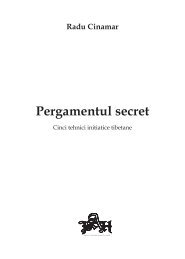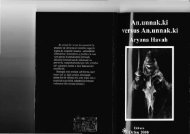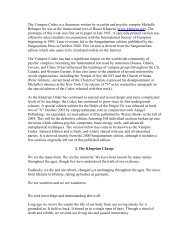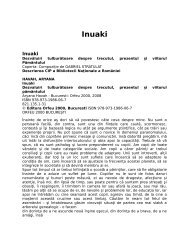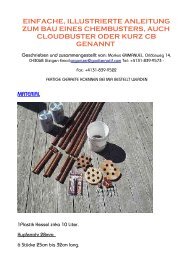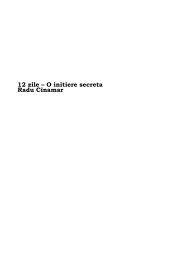Modern Orgone - Transkommunikation.ch
Modern Orgone - Transkommunikation.ch
Modern Orgone - Transkommunikation.ch
You also want an ePaper? Increase the reach of your titles
YUMPU automatically turns print PDFs into web optimized ePapers that Google loves.
Acoustic Recordings from Antiquity<br />
Abstract—Pioneering experiments establishing<br />
the principles of recalling ancient sounds from<br />
antiquity are reported.<br />
Widespread resear<strong>ch</strong> on recalling from the<br />
past actual sounds, voices, music, etc.,<br />
adventitiously recorded by ancient peoples (or<br />
events) upon the “surface” or within the<br />
substance of a wide variety of objects and<br />
artifacts crafted (or evolved) from “plastic”<br />
media warrants intensified efforts at the<br />
present time, because of recent developments<br />
in electronic signal analysis whi<strong>ch</strong> can ferret<br />
out “signals” buried in “noise”.<br />
This letter is primarily intended to call attention<br />
to the potentials of Acoustic Ar<strong>ch</strong>aeology and<br />
to record the early experiments whi<strong>ch</strong><br />
established the principle.<br />
Two areas of the author’s investigation, whi<strong>ch</strong><br />
began in 1961, will be of interest: 1) the<br />
recording of sound on wheel-thrown clay pots,<br />
and 2) the recording of sound in paint strokes<br />
applied to canvas.<br />
The sound-reproducing system used consisted<br />
of a crystal cartridge (Asiatic Corp., Model 2)<br />
su<strong>ch</strong> as is used in phono pickups. The<br />
cartridge was connected directly to a set of<br />
inexpensive earphones (Trimm “Acme.” 2000<br />
ohms). The <strong>ch</strong>uck of cartridge could be fitted<br />
with “needles” of any suitable material, length,<br />
shape, etc. In all instances the cartridge was<br />
held in the fingers and could be positioned<br />
against a revolving pot mounted on a phono<br />
turntable (adjustable speed) or “stroked” along<br />
a paint stroke, etc.<br />
Sound Recorded on Pottery<br />
First Example<br />
This consisted of a pot of fine clay, hand<br />
thrown on a potter’s wheel. The wheel in this<br />
example was an old, student-made wheel,<br />
constructed of an automobile crankshaft and<br />
flywheel mounted in a (too) light wooden<br />
frame. Persistently out of alignment, the wheel<br />
had a noisy vibration almost amounting to a<br />
<strong>ch</strong>atter. The pot produced on this wheel was<br />
fired at low temperatures.<br />
When the pot was suitably mounted on the<br />
phono turntable and against the side of the<br />
revolving pot was held the phono cartridge<br />
(fitted, in this instance, with a “needle”<br />
consisting of a flat-ended sliver of wood threequarters<br />
of an in<strong>ch</strong> long) the low-frequency<br />
<strong>ch</strong>atter could be heard in the earphones.<br />
Second Example<br />
This was similar to the first example except it<br />
was a commercial pot whi<strong>ch</strong> had been hand<br />
thrown on a motor-driven potter’s wheel. The<br />
60 Hz motor was mounted directly on the<br />
frame supporting the wheel to whi<strong>ch</strong> it<br />
imparted a loud hum. Using the phono<br />
cartridge as above with a similar needle, areas<br />
could be found on the surface of the revolving<br />
pot where the hum could be picked up.<br />
In both examples, it should be noted, the last<br />
act of the potter, prior to removing the pot from<br />
the wheel, was to “smooth” the surface of the<br />
pot using the “sharp” edge of a thin rib of<br />
wood.<br />
Sound Recorded in Paint Strokes<br />
This is of particular interest as it introduces the<br />
possibility of actually recalling and hearing the<br />
voices and words of eminent personages as<br />
recorded in the paint of their portraits or of<br />
famous artists in their pictures.<br />
First Example<br />
A canvas affixed to a small, square wooden<br />
frame was so stationed as to be able to vibrate<br />
freely. This it would do when “spoken to” or<br />
where subjected to music from a nearby<br />
phonograph—as determined by tou<strong>ch</strong>ing it to<br />
the “needle” (wooded sliver) of the crystal<br />
cartridge and listening in the earphones.<br />
With an artist’s brush, paint strokes were<br />
applied to the surface of the canvas using “oil”<br />
paints involving a variety of plasticities,<br />
thicknesses, layers, etc., while martial music<br />
was played on the nearby phonograph. Visual<br />
examination at low magnification showed that<br />
certain strokes had the expected transverse<br />
striated appearance. When su<strong>ch</strong> strokes, after<br />
drying, were gently stroked by the “needle”<br />
(small, wooden, spade-like) of the crystal<br />
cartridge, at as close to the original stroke<br />
speed as possible, short snat<strong>ch</strong>es of the<br />
original music could be identified.<br />
Second Example<br />
This is to record the finding of a spoken word<br />
in an oil portrait. The word was “blue” and was<br />
located in a blue paint stroke—as if the artist<br />
was talking to himself or to the subject.<br />
Parenthetically, the sear<strong>ch</strong> was long and<br />
30





